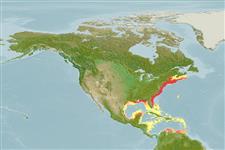Environment: milieu / climate zone / profondeur / distribution range
Écologie
marin; saumâtre démersal; profondeur 15 - 170 m. Temperate; 46°N - 10°N, 98°W - 60°W
Western Atlantic: Nova Scotia in Canada to central Florida in USA. Gulf of Mexico (Ref. 26938).
Taille / Poids / Âge
Maturité: Lm ? range ? - ? cm
Max length : 38.0 cm TL mâle / non sexé; (Ref. 7251); common length : 30.0 cm TL mâle / non sexé; (Ref. 3822)
Occurs on sandy bottom. Feeds on shrimps, crabs, other crustaceans, squid, bivalves and small fishes. Produces loud, drumming sound by vibrating its swim bladder (Ref. 9988). Used both for food and fish meal; other uses include bait for lobster traps and flatfish, handlines, pet food and fertilizer. Utilized fresh and frozen; also used for caviar ; can be broiled and baked (Ref. 9988).
Life cycle and mating behavior
Maturité | Reproduction | Frai | Œufs | Fécondité | Larves
Robins, C.R. and G.C. Ray, 1986. A field guide to Atlantic coast fishes of North America. Houghton Mifflin Company, Boston, U.S.A. 354 p. (Ref. 7251)
Statut dans la liste rouge de l'IUCN (Ref. 130435: Version 2025-1)
Menace pour l'homme
Harmless
Utilisations par l'homme
Pêcheries: intérêt commercial mineur; appât: occasionally
Outils
Articles particuliers
Télécharger en XML
Sources Internet
Estimates based on models
Preferred temperature (Réf.
123201): 6.4 - 24.7, mean 18.9 °C (based on 85 cells).
Phylogenetic diversity index (Réf.
82804): PD
50 = 0.5000 [Uniqueness, from 0.5 = low to 2.0 = high].
Bayesian length-weight: a=0.00513 (0.00258 - 0.01018), b=3.19 (3.01 - 3.37), in cm total length, based on LWR estimates for this species & (Sub)family-body (Ref.
93245).
Niveau trophique (Réf.
69278): 4.1 ±0.0 se; based on diet studies.
Generation time: 3.7 ( na - na) years. Estimated as median ln(3)/K based on 1
growth studies.
Résilience (Réf.
120179): Milieu, temps minimum de doublement de population : 1,4 à 4,4 années (K=0.3).
Fishing Vulnerability (Ref.
59153): Low to moderate vulnerability (35 of 100).
🛈
Nutrients (Ref.
124155): Calcium = 49.7 [26.9, 103.6] mg/100g; Iron = 0.418 [0.221, 0.752] mg/100g; Protein = 16.6 [14.1, 19.5] %; Omega3 = 0.686 [0.305, 1.832] g/100g; Selenium = 14.8 [7.1, 33.4] μg/100g; VitaminA = 22.9 [8.7, 63.4] μg/100g; Zinc = 0.571 [0.403, 0.805] mg/100g (wet weight);
